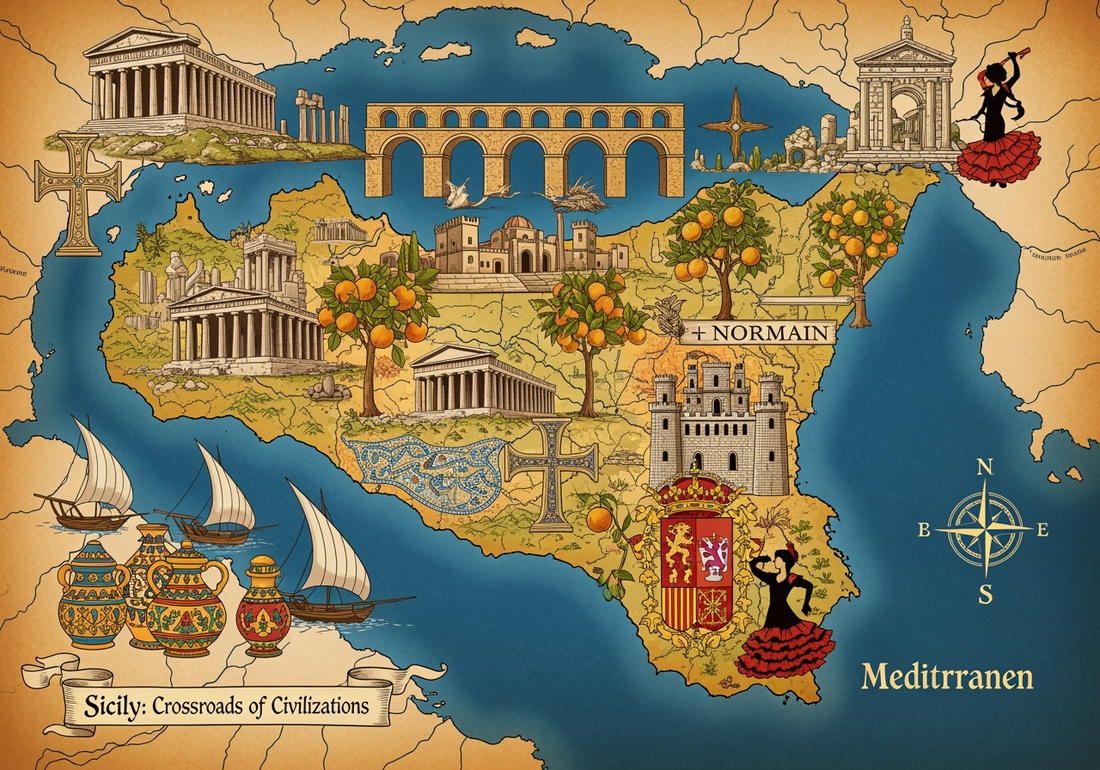
Sicily: Where History and Food Are Forever Entwined.
Rosario MarottaShare
Sicily: Where History and Food Are Forever Entwined
A Crossroads of Cultures
Sicily has always been a crossroads—invaded, settled, and influenced by Greeks, Romans, Arabs, Normans, Spanish, and more. Every wave of people brought new flavors, crops, and cooking traditions, creating a food culture unlike anywhere else in the world.

Caption: Sicily’s unique food culture comes from centuries of Mediterranean influences.
Ancient Roots
The Greeks arrived in the 8th century BC, bringing olives, grapes, and wheat, and laying the foundation for the Mediterranean diet. Under Roman rule, Sicily became the “breadbasket of Rome,” its fertile plains producing vast amounts of grain.

Caption: Greek and Roman agriculture shaped Sicily’s land and table.
Arab Influence: The Sweet & The Exotic
Perhaps the most profound culinary transformation came with the Arab conquest in the 9th century. The Arabs introduced sugar, citrus fruits (like lemons and oranges), rice, pistachios, almonds, saffron, and spices. They also brought new cooking methods and the love of sweet-and-sour flavors, which you still find in classic Sicilian dishes like caponata and agrodolce sauces.

Caption: Arab traders brought citrus, rice, and sweet flavors to Sicily’s kitchens.
Spanish, Norman, and French Layers
The Normans and later the Spanish brought new ingredients and tastes. The Spanish also introduced marzipan, which became a staple in Sicilian pastry. French influence, especially during the Bourbon period, refined Sicilian desserts and baking.

Caption: Norman, Spanish, and French influences layered new flavors onto Sicily’s food.
The Land Shapes the Table
Sicily’s geography is as varied as its history. The mountains and hills are home to sheep and goats, whose milk is used for cheeses like pecorino and ricotta. The coasts offer a bounty of seafood—tuna, sardines, swordfish, and anchovies. The volcanic soil of Mount Etna produces some of Italy’s best wines and fruits.

Caption: Sicily’s land provides everything from cheese and seafood to world-class wine.
Today’s Sicilian Table: A Living Mosaic
Today, Sicilian cuisine is a true fusion—a living mosaic of all these influences. You’ll find pasta with sardines and wild fennel (Greek and Arab), arancini rice balls (Arab), cannoli and cassata cakes (Arab and Spanish), and granita (Arab). Even simple breads and olives carry centuries of tradition.

Caption: Sicilian meals today are a colorful mix of traditions, flavors, and family.
Food as Memory and Identity
For Sicilians, food is much more than sustenance—it’s a way to remember history, honor ancestors, and celebrate community. Every family has recipes passed down for generations, each dish telling a story of survival, adaptation, and pride.

Caption: Food in Sicily is family, memory, and tradition—passed down with love.
Why It Matters Now
Sicily’s food culture remains vibrant and unique because it has always welcomed outside influences and made them its own. This spirit of openness, creativity, and resilience is what makes Sicilian food so special—and why it continues to inspire chefs and home cooks around the world.

Caption: Sicily’s food festivals celebrate a living, ever-evolving culinary tradition.
Sicilian food isn’t just about what’s on the plate. It’s about where you come from, who you share it with, and the history that flavors every bite. At Sicilian Thing, we’re proud to carry on this tradition, bringing a taste of Sicily’s rich past to your table today.
By Rosario, Owner of Sicilian Thing / Marotta IEWD

